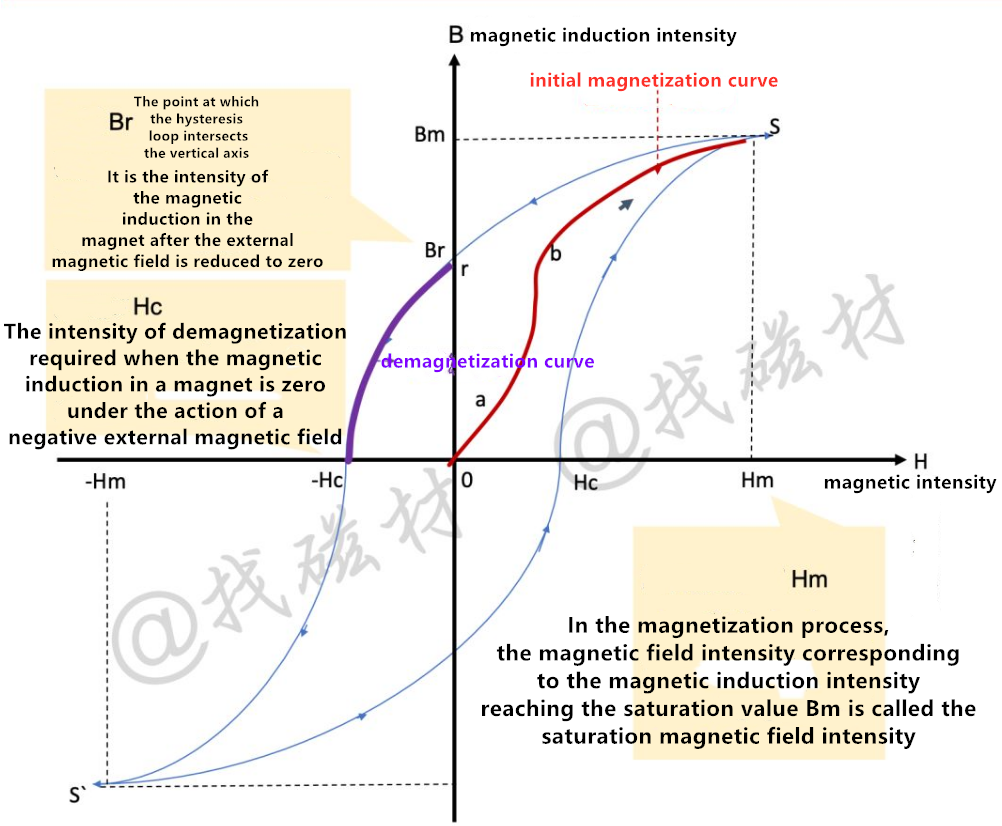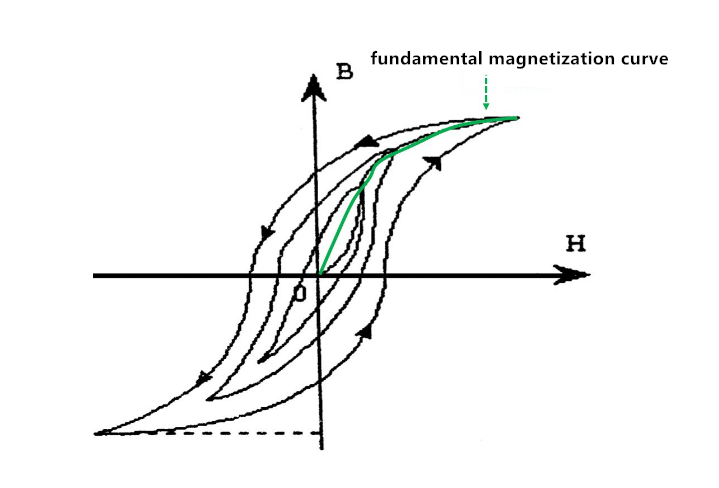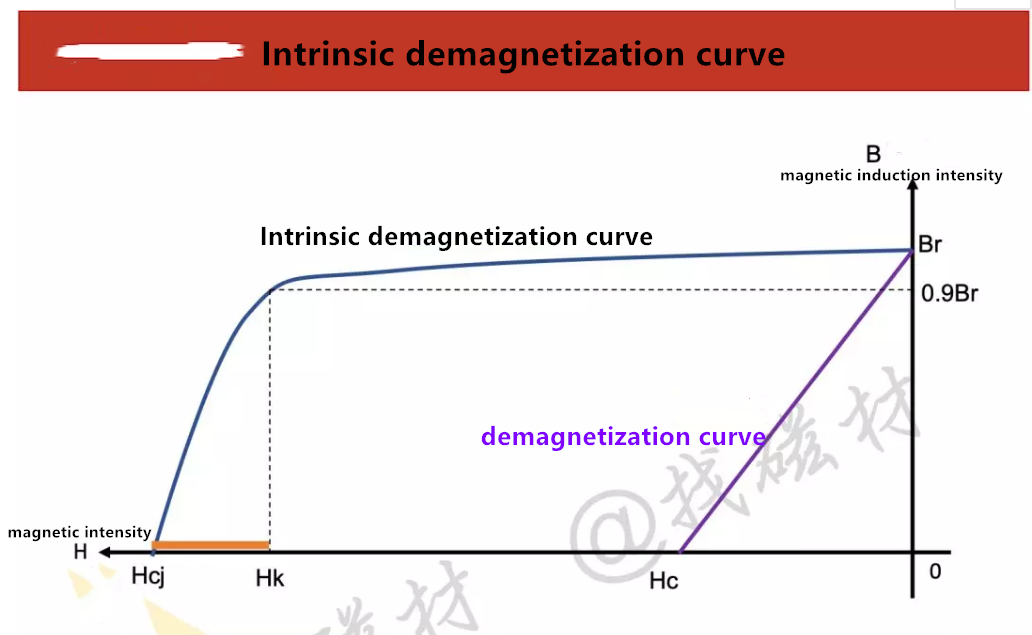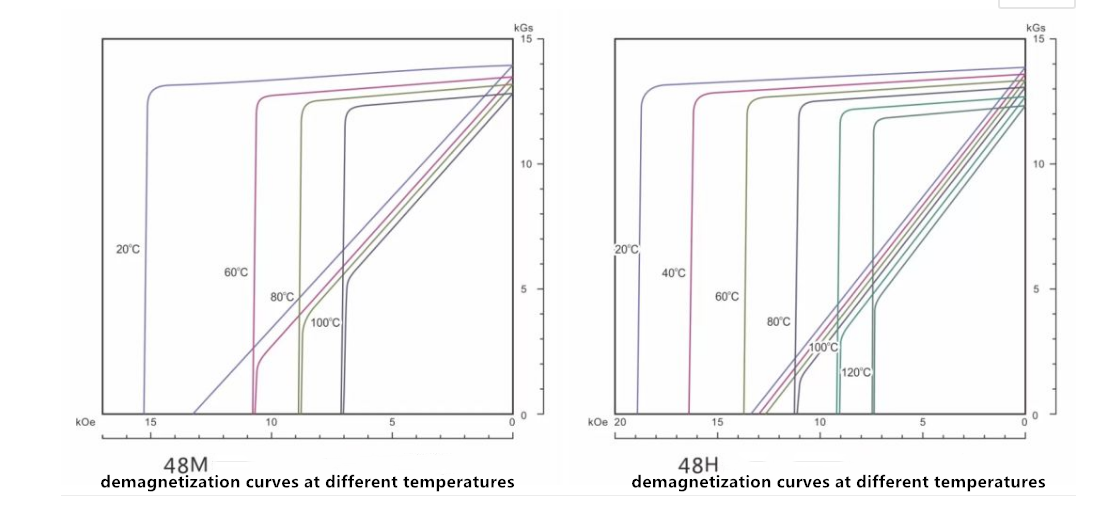To understand the Hysteresis loop

Do you think the hysteresis curve is too complicated to understand? And demagnetizing curve, intrinsic curve and magnetic energy product curve are easily confused? Actually, you don’t understand some of the basic concepts of magnetism. Let me explain to you.
Hard magnetic materials,such as NdFeB, have two distinct characteristics, one is that it can be strong magnetized by an external magnetic field, the other one is hysteresis, that is , the hard magnetic material still retains magnetization state after removing the external magnetic field. The graph below shows the relationship curve between magnetic induction intensity B and magnetization field intensity H of hard magnetic materials.

When the magnetic field changes in order according to Hm→Hc→O→Hc→Hm→Hc→O→Hc→Hm, the corresponding magnetic induction intensity B changes along the closed curve, which is called hysteresis curve(blue curve above).
Initial magnetization curve
The origin 0 in the figure indicates that the hard magnetic material is in a magnetically neutral state before magnetization, that is, B=H=0, when the magnetic field H to increases from zero, the magnetic induction intensity B increases slowly, as shown in the line Oa, then B increases rapidly with H, as shown in the line ab, then B’s growth slowed down again, and when H increases to Hm, B reaches the saturation value Bm, this red curve is called the initial magnetization curve.
Hysteresis loop
When the magnetic field decreases from Hs to zero gradually, the magnetic induction intensity B dosen’t return to the zero point along with the initial magnetization curve, but decreases along another new curve “Sr”, by comparing line segment OS and Sr, it has been seen that H decreases and B decreases correspondingly , but the change of B lags behind the change of H, this phenomenon is called hysteresis, the obvious of hysteresis is when H=0, B is not zero, but residual Br is retained.
Demagnetization curve
When the magnetic field reverses gradually from o to -Hc, the magnetic induction intensity B disappears, this means that if eliminate remanence, a reverse magnetic field must be applied, Hc is called coercivity, its size reflects the magnetic material’s ability to maintain the remanent magnetic state, and the purple segment is called the demagnetization curve.
Fundamental magnetization curve
The same ferromagnetic material is magnetized repeatedly with different magnetic filed intensity H, and multiple hysteresis loops of different sizes can be obtained, as shown in the figure below. Connecting the vertices of each hysteresis loop, the resulting curve is called the fundamental magnetization curve or the average magnetization curve. The fundamental magnetization curve and initial magnetization curve are not the same line, but there is little difference between them, the magnetization curves used in the calculation of DC magnetic circuit are fundamental magnetization curve.

Intrinsic curve
The intrinsic magnetic induction intensity of a permanent magnetic material magnetized by an external magnetic field, it is called intrinsic magnetic induction intensity Bi, also known as magnetic polarization intensity J. The curve describing the relationship between the intrinsic magnetic induction intensity Bi(J) and the magnetic field induction H is the curve reflecting the intrinsic magnetic property of the permanent magnetic material, called the intrinsic demagnetization curve, or the intrinsic curve for short.
When the magnetic induction intensity B on the intrinsic curve is zero, the corresponding magnetic field intensity is called intrinsic coercivity Hcj. The value of the intrinsic coercivity relects the anti-demagnetization capability of the permanent magnetic material.

We often hear about the rectangular degree or square degree of the intrinsic curve, which is the ratio of Hk to Hcj in the intrinsic curve. The larger the ratio, the shorter the orange segment, the more stable the magnetic property. Hk is the value of demagnetization magnetic intensity corresponding to the intrinsic curve when Bi=0.9Br, which is one of the required parameters of permanent magnetic materials. Generally speaking, manufacturers of permanent magnet materials will provide intrinsic curves of each grade at different operating temperatures, as shown below. It may seem complicated, but the essence is to present multiple demagnetization curves and intrinsic curves on a single graph.

Main parameters of permanent magnetic materials
The shape and characteristics of the hysteresis curve of permanent magnetic materials can be expressed by several parameters, in practical applications, magnetic materials can be classified the according to the quantitative differences of these parameters, and their use can be determined, these parameters are also the main bases of magnetic circuit design.
1.Saturation magnetic field intensity Hm
In the magnetization process of the magnetic materials, the magnetic field intensity which makes its magnetic induction intensity B reach the saturation value Bm is called saturation magnetic field Hm. The magnetic materials should be completely magnetized when magnetizing, in other words, the magnetizing magnetic field intensity H should reach the value of Hm to obtain the demagnetization curve of maximum possible magnetization. This demagnetization curve is the most stable and can show the optimal magnetic properties of the material. If the magnetizing magnetic field intensity H is lower than Hm, there will be hysteresis curves of different shapes, and the demagnetization curves will be unstable, and the magnetic properties displayed by the magnet will also be low.
This shows that the Hm value of the magnetic materials used should be known in the magnetic material production process, and the magnetic field must reach or even exceed this value in the magnetization process.
2. Remanence Br
The point at which the hysteresis curve intersects vertical axis, that is, the B value at the beginning of the demagnetization curve is called residual magnetic induction intensity , or remanence, as Br. It’s the magnetic induction intensity value of the magnetic material in the magnet after removing the external magnetic field.
3. Magnetic induction coercivity Hc
Under the action of negative magnetic field, the magnetic induction intensity B in the magnet decreases with the increases of the demagnetization field. The demagnetization magnetic field intensity required to make the magnetic induction intensity B in the magnet reach zero is called magnetic induction coercivity, or coercivity for short, expressed by Hc or Hcb.
4. The permeability
The slope at any point on the initial magnetization curve and the hysteresis curve, the ratio of the increment of B to H at any point is called permeability, it varies from point to point. Soft magnetic materials have high permeability, while permanent magnetic materials/hard magnetic materials have low permeability.
Generally speaking, the smaller the ratio of remanence Br to coercivity Hc, the smaller the permeability. For permanent magnets, people usually care about the initial permeability, the maximum permeability and the reversible permeability.
It can be said that the magnetization curve and hysteresis loop are the main basis for classification and selection of magnetic materials. The pictures below are typical hysteresis loops.
5. Magnetic energy product and maximum magnetic energy product
The product of magnetic flux density/magnetic induction intensity B and magnetic field intensity H at any point on the demagnetization curve of a permanent magnet is called magnetic energy product BH. Its size is proportional to the magnetic energy density of the magnet in a given working state. The relationship between the magnetic energy product and the magnetic induction intensity B is called the magnetic energy product curve, it’s the curve obtained by taking the product of B and H values on the demagnetization curve of permanent magnet as the x-coordinate, and the magnetic flux density B as the y-coordinate.
Somewhere in the middle of the demagnetization curve the magnetic energy product reaches its the maximum value and becomes the maximum magnetic energy product (BH)max. For permanent magnetic materials with a straight demagnetization curve, the magnetic energy is maximized at (Br/2, Hc/2).
